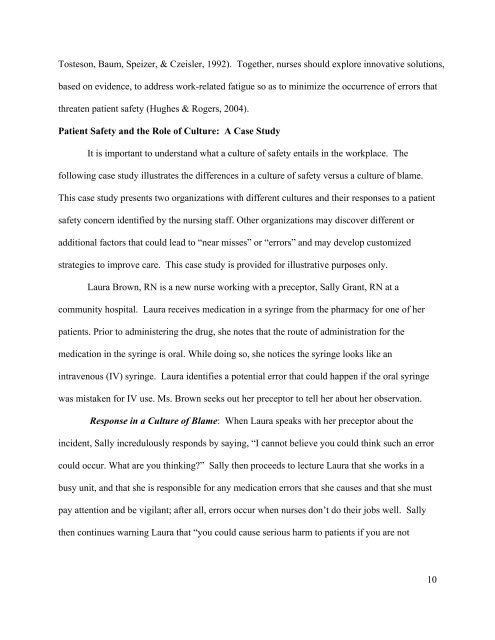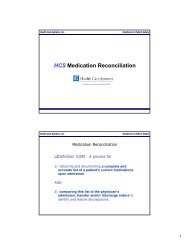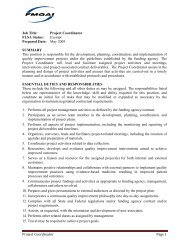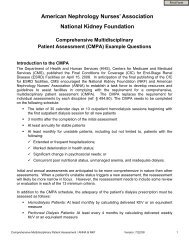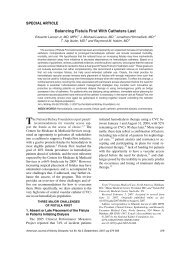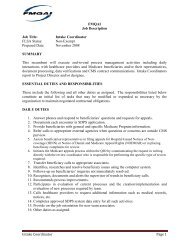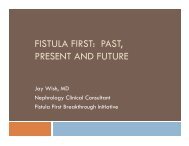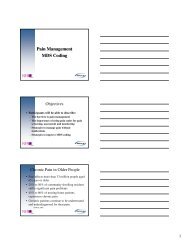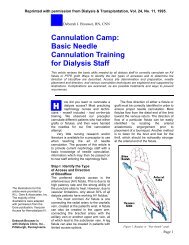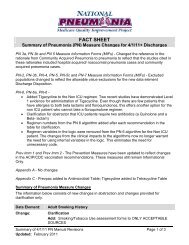The Nurse's Role in Promoting a Culture of Patient Safety - FMQAI
The Nurse's Role in Promoting a Culture of Patient Safety - FMQAI
The Nurse's Role in Promoting a Culture of Patient Safety - FMQAI
You also want an ePaper? Increase the reach of your titles
YUMPU automatically turns print PDFs into web optimized ePapers that Google loves.
Tosteson, Baum, Speizer, & Czeisler, 1992). Together, nurses should explore <strong>in</strong>novative solutions,<br />
based on evidence, to address work-related fatigue so as to m<strong>in</strong>imize the occurrence <strong>of</strong> errors that<br />
threaten patient safety (Hughes & Rogers, 2004).<br />
<strong>Patient</strong> <strong>Safety</strong> and the <strong>Role</strong> <strong>of</strong> <strong>Culture</strong>: A Case Study<br />
It is important to understand what a culture <strong>of</strong> safety entails <strong>in</strong> the workplace. <strong>The</strong><br />
follow<strong>in</strong>g case study illustrates the differences <strong>in</strong> a culture <strong>of</strong> safety versus a culture <strong>of</strong> blame.<br />
This case study presents two organizations with different cultures and their responses to a patient<br />
safety concern identified by the nurs<strong>in</strong>g staff. Other organizations may discover different or<br />
additional factors that could lead to “near misses” or “errors” and may develop customized<br />
strategies to improve care. This case study is provided for illustrative purposes only.<br />
Laura Brown, RN is a new nurse work<strong>in</strong>g with a preceptor, Sally Grant, RN at a<br />
community hospital. Laura receives medication <strong>in</strong> a syr<strong>in</strong>ge from the pharmacy for one <strong>of</strong> her<br />
patients. Prior to adm<strong>in</strong>ister<strong>in</strong>g the drug, she notes that the route <strong>of</strong> adm<strong>in</strong>istration for the<br />
medication <strong>in</strong> the syr<strong>in</strong>ge is oral. While do<strong>in</strong>g so, she notices the syr<strong>in</strong>ge looks like an<br />
<strong>in</strong>travenous (IV) syr<strong>in</strong>ge. Laura identifies a potential error that could happen if the oral syr<strong>in</strong>ge<br />
was mistaken for IV use. Ms. Brown seeks out her preceptor to tell her about her observation.<br />
Response <strong>in</strong> a <strong>Culture</strong> <strong>of</strong> Blame: When Laura speaks with her preceptor about the<br />
<strong>in</strong>cident, Sally <strong>in</strong>credulously responds by say<strong>in</strong>g, “I cannot believe you could th<strong>in</strong>k such an error<br />
could occur. What are you th<strong>in</strong>k<strong>in</strong>g?” Sally then proceeds to lecture Laura that she works <strong>in</strong> a<br />
busy unit, and that she is responsible for any medication errors that she causes and that she must<br />
pay attention and be vigilant; after all, errors occur when nurses don’t do their jobs well. Sally<br />
then cont<strong>in</strong>ues warn<strong>in</strong>g Laura that “you could cause serious harm to patients if you are not<br />
10


